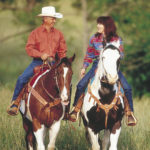Kari Frolander of Enterprise, Oregon, owned her first horse before she could walk. At 14, she trained and cared for horses to save up enough money to buy a horse. She won the county all-around horseman title every year of her eight-year 4-H career.

So it’s not a stretch to say that Kari lives and breathes horses. That connection with horses carried through to her relationship with BKT Pitchin Penny, a mare she bought as a 3-year-old in 1992. ?Penny? had been a reliable broodmare for years, but one year, it was different. In 2007, Kari told America?s Horse about her experiences.
?I had Penny for 14 years and never missed one of her 11 foalings,? Kari says. ?She wouldn?t ever wax up; she?d start dripping milk a little before she foaled. When it was time, she would nicker at me to get off my butt and come out to watch. She?d have three contractions, and then the foal would pop right out.?
That consistency is what made Kari notice that Penny?s 11th pregnancy seemed different.
?I told my husband that she was carrying a foal a lot lower than any of the others,? Kari says. ?That whole pregnancy was different. She just didn’t look right.?
On cue, though, Penny notified Kari when it was time for baby to come.
?He was huge; the biggest colt she?d ever had,? Kari says. ?She always let me come in and clean off the babies and play with them. I did the same with the newest foal.?
But the next day, something wasn?t right.
?I went out to check on them, and Penny was standing there with her head hanging low,? Kari says.
Kari immediately called her vet.
?Within a couple of hours, her belly was really swollen,? Kari says.
Kari?s veterinarian determined that Penny had ruptured a uterine artery and probably would not survive the five-hour trip to the equine hospital for surgery. Kari elected to put her down.
?The foal never crossed my mind during the whole time we were concentrating on Penny,? Kari says. ?Honestly, I was kind of mad at him for hurting her ? even though it really wasn?t his fault. My main concern at the time was making her comfortable.?
Then Penny was gone.
?I turned around and saw this palomino foal and thought, ?Oh, crap!?? Kari says.
She decided right off the bat that the orphaned foal was not going to be a typical orphan with puppy-like mannerisms.
Kari?s first job was to match up ?Peppy? with a nurse mare from a nearby breeder.
Need a Wet Nurse?
?A nurse mare is the best option for caring for your foal because she can provide milk and will teach the foal how to be a horse,? says Dr. Dana Zimmel, a veterinarian and professor at the University of Florida?s department of large animal science.
This approach sounds simple in theory. However, a nurse mare can be costly (sometimes up to $3,000). And besides availability and cost effectiveness, there are other variables. Will the mare reject the foal; will she have enough milk to sustain it?
Sherry Faulkner of Greenwood, South Carolina, endured two weeks of sleepless nights before Solanos Dun Jokin accepted her orphan foal Haidas Wild Bill. After their introduction, ?Solano? let ?Bill? nurse and seemed fine with him throughout the day, but the next morning, Sherry found him cornered in the stall with bite marks all over him and Solano lunging to inflict more damage. Sherry attempted to short-circuit the mare?s olfactory response by rubbing Vicks Vaporub, as well as Solano?s milk, on the mare?s nostrils and on Bill?s rump.
?I don’t know if I would say she finally accepted him or tolerated him, but whatever it was, she did it,? Sherry says.
Jennifer Holzum of Oakland, California, had no problem finding a nurse mare for her orphan foal. Her mare, Dee Easy Becky, died from a uterine infection five hours after birth. The mare was down in the pasture but the foal, The Last Easy Frost, was nowhere to be found. Jennifer found him with the rest of the herd, suckling a buckskin mare as the mare?s foal calmly stood by. Jennifer brought the mare and foals into the barn.
?I guess he was just an aggressive colt,? Jennifer says. ?He said ?I need to drink some milk.? He actually kicked her when she tried to bite him. He wasn?t going anywhere.?
Creating a nurse mare is another choice. This technique has only been available in the last several years and costs from $400 to $800. The mare must have produced at least one foal but currently be open. Hormones are administered to the mare orally and through intramuscular injections to get the mare to produce milk. After seven days of treatment, a veterinarian massages the mare?s cervico vaginal region to imitate foaling. The orphan foal is then introduced.
This procedure runs the same risk of the mare not accepting the foal. Also, the mare can become sore from the continued injections. Even if she does not accept the foal, and is not nursing, the mare must continue to receive hormones for two weeks.
In Kari?s case, she was unable to match Peppy with a nurse mare, so she decided to hand-raise the foal, using a substitute for mare?s milk.
Cow?s milk is readily available but does not contain enough sugar or protein. Goat?s milk, the prime choice before the development of mare milk replacer, can be used without alteration but it is greasy, slippery and requires a large freezer to maintain if you do not raise goats. Also, it is rather expensive.
?I think the milk replacers on the market are just as good as goat?s milk. They have come a long way,? Dr. Zimmel says.
Commercial milk replacers are convenient, closely resemble mare?s milk and are palatable to foals. Most are produced as a powder and are rehydrated with water. Foals generally do well on milk replacers, with growth rates similar to foals raised on their dams. If you use a milk replacer, it is common for your foal to develop mild diarrhea. This should not be a cause for alarm but if it persists, contact your veterinarian.
?The crucial thing is that people mix the milk as required on the package. Do not try to make it more concentrated to give your foal more calories. The electrolytes in the formula are designed for the way it is supposed to be prepared. I have had people make their foals sick from this. Do not substitute anything like Gatorade either. It will not balance the electrolytes,? Dr. Zimmel says.
Bottle Baby?
An orphaned foal can be fed by a bottle or bucket. A foal will usually nurse willingly from a bottle since its initial instinct is to suckle. Calf nipples are too large, but lamb nipples work. Some baby bottles may also be used. Whichever type you select, make sure the hole in the nipple is not too big. When the bottle is inverted, the contents should not run freely from the nipple, which could cause the foal to inhale the milk into its lungs.
For nursing, the foal should be placed in an upright position, decreasing the likelihood of the milk traveling into the windpipe instead of the esophagus. Place the foal?s nose under your arm and place the nipple over the tongue. A healthy foal will only nurse until it is full, so allow it to drink freely.
Bottle feeding has its challenges: A foal must be bottle-fed every two hours, and the close contact with the foal could encourage it to become socialized to humans by associating you as its parents. That’s what concerned Kari.
?I had raised a lot of orphan calves, lambs and goats,? Kari says. ?I didn’t want to raise Peppy on a bottle because I didn’t want him to think of me as his mother, and I didn’t want him to think he could butt me or anyone else with his head like a lot of orphans do.?
So, she immediately started feeding him milk replacer out of a bucket.
?I just put him in a headlock and stuck his nose down in the milk,? Kari says with a nervous laugh. ?I was determined that he was going to learn to drink the milk.?
If you choose to use a bucket, begin by letting your foal suckle a milk-wet finger, then gradually direct it to the milk until it begins to drink from the bucket. If the foal does not grasp the idea at first, move your finger against its upper palate to stimulate the nursing response. This process can take a bit for the foal to get the idea, but most will catch on quickly.
?Once he figured it out, it was smooth sailing,? Kari says. ?I?d take the bucket of milk out every two hours, and he would drink his milk.?
Since Peppy (registered as Zans Pitchin Peppy) had the run of the yard in Kari?s place in far northeast Oregon, Kari was able to sneak the milk into the bucket, then call him to come eat.
?He never saw me put the milk in the bucket, so he could never associate it coming from me,? she says. ?I never petted him while he was eating. I didn’t want him thinking getting milk meant getting attention from me. After he was done eating, I?d halter him, tie him up, groom him and work with him.?
Once a method of feeding is selected, owners should monitor the foal?s progress carefully. Dr. Dana Zimmel, a veterinarian and professor at the University of Florida?s department of large animal science, suggests daily weighing.
?If an orphan foal seems a bit small compared to its peers, don’t worry,? Dr. Zimmel says. ?By the time the foal becomes a yearling, it will catch up.
?You can weigh the foal by holding it while standing on a bathroom scale,? says Dr. Zimmel. ?A properly growing foal should gain one to two pounds a day.?
When Peppy was 2 months old, Kari had him gelded, and her vet was astonished by how well Peppy had grown.
?He said he had clients with normal foals raised on mares that weren?t as big and healthy as Peppy,? Kari says. ?He said whatever I was doing, keep it up. Then I knew I was on the right track.?
She weaned him from milk at 4 months of age and transitioned him to pellets.
Starting Solids
The sooner an orphan accepts solid feed, the better. Lori Warren, assistant professor of equine nutrition at the University of Florida, says that when an orphan is about 2 weeks old, the owner should start giving him good-quality, leafy hay with no seed heads, and foal pellets.
Foals raised on a mare show an interest in solid foods at this age because they mimic their mom?s behavior. The desire to mouth solid feed exists with orphans, but they have no one to show them the ropes. Therefore, they may sample the hay and ingest it over time.
Lori advises against feeding cereal grains until a foal is at least a month old.
?Sweet feeds or pellets or pellets with oats, corn, etc. should never be offered until the foal is a month old,? Lori says. ?Young foals do not yet have the enzymes needed to digest the types of carbohydrates in these grains.?
Ann Secrest Hanson of Bowman, North Dakota, weaned her month-old filly, James Belles Last, after the filly?s momma, James Belle 921, suffered from mastitis.
?The mare?s bag shriveled up, so I put the filly on good alfalfa hay,? Ann says. ?She didn’t eat much, but I tied up her mother to give her a chance. I didn’t want to separate them because I wanted her mother to teach her how to be a horse.?
Another option is foal pellets. They are formulated from milk carbohydrates and milk proteins that are easily digestible. Many times, foal pellets are not only similar in composition to milk replacer, but are often the exact same product, only in a different form. The challenge is encouraging the foal to eat them.
If the orphan is bucket-fed, sprinkle a handful of pellets in the empty bucket. Coat the pellets with dry milk replacer so they smell familiar. The foal might not each much of the pellets when they initially presented, so each time pellets are offered, make sure they are fresh.







